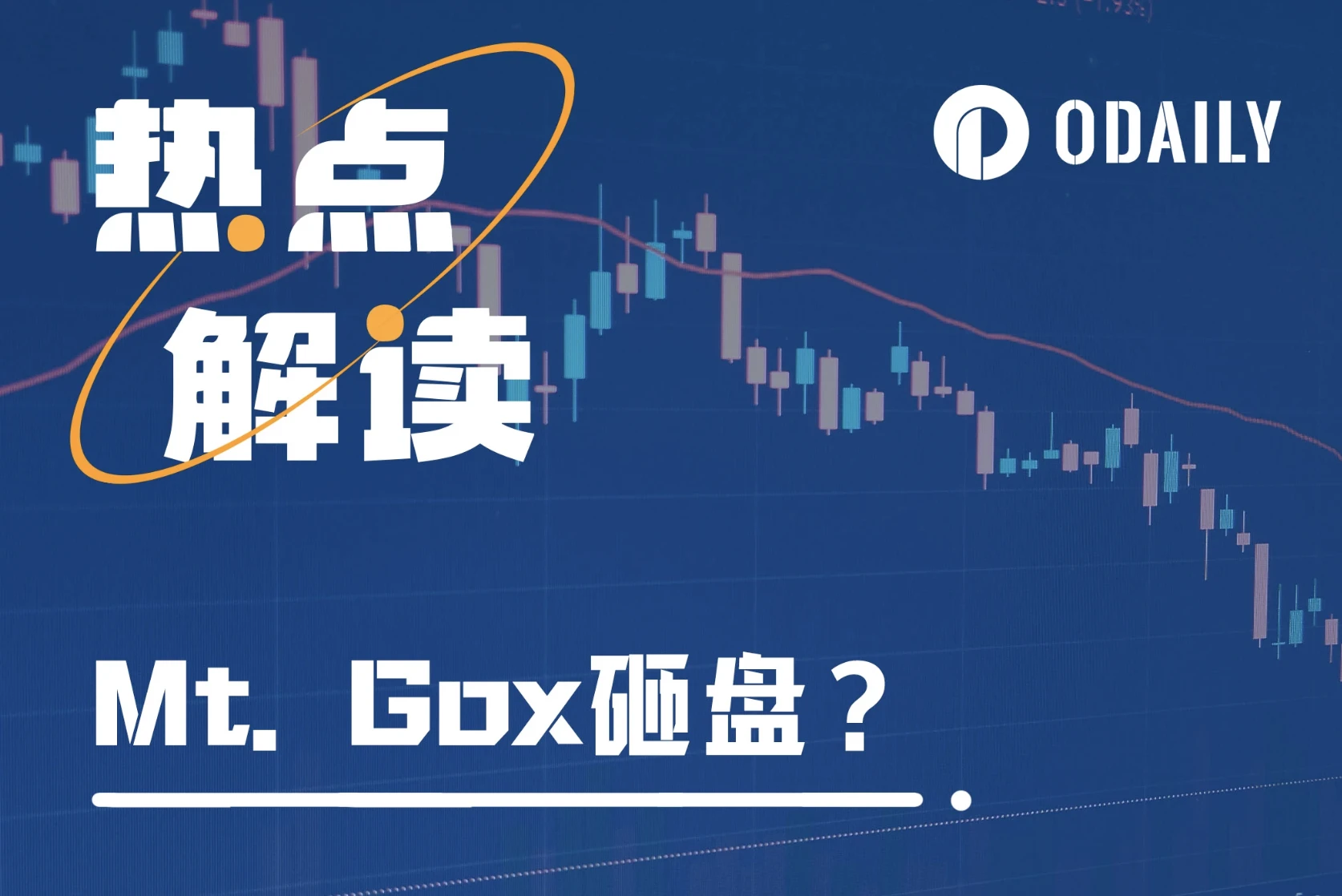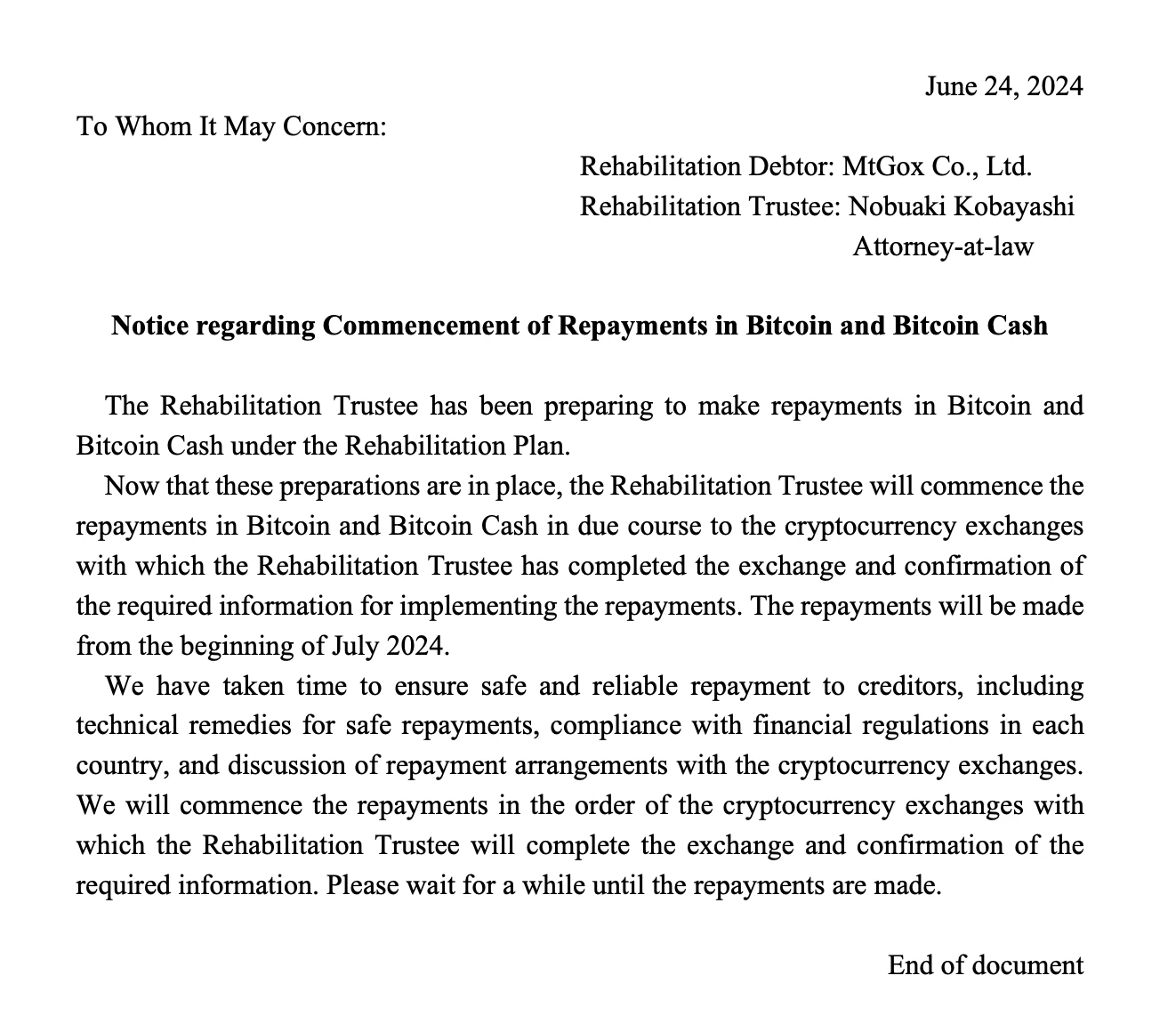Ten questions and ten answers to dispel the rumors surrounding the Mt. Gox incident
Original | Odaily Planet Daily
Author | Azuma
On the afternoon of June 24th, Beijing time, a news about Mt.Gox will initiate BTC and BCH repayments quickly triggered the market. Due to concerns about potential selling pressure, the already weak cryptocurrency market was further frustrated. BTC once fell below the $60,000 mark, and ETH also once approached $3,200.
However, there is still a lot of confusion and even rumors about the Mt. Gox repayment incident itself, so that most readers do not know the full picture of the incident, and thus cannot actively assess the potential impact of the incident on the market. In order to dispel these doubts, Odaily Planet Daily will combine market data and interviews with creditors (dForce founder Mindao) to clarify this information in the form of questions and answers.
-
Q1: Is this the first time Mt.Gox has made a debt repayment?
A1 : No, as early as December 21, 2023, many Japanese-speaking users posted on social media that they had received compensation in Japanese yen through PayPal, including Yuzo Kano, the founder of Japans leading exchange bitFlyer.
Combined with the email notice from Mt. Goxs bankruptcy liquidator Nobuaki Kobayashi at the time, it can be seen that this part of the compensation funds came from the 7 billion yen redeemed by Nobuaki Kobayashi from the bankruptcy trust on November 17, 2023.
-
Q2: Why is this repayment so special?
A2 : Because this is the first time that Mt.Gox has made repayments in the form of BTC and BCH, it means that the 141,686 BTC (and a roughly equal amount of BCH) held by Mt.Gox will begin to flow into the market.
These BTC account for 0.72% of the total circulating supply of Bitcoin and are worth approximately $8.54 billion.
-
Q3: When will repayment be made – when will the selling pressure come?
A3 : According to the latest email notification from Nobuaki Kobayashi, repayment will begin in July 2024.
-
Q4: The most critical question is, what are the repayment details?
A4 : Creditor Mindao stated that Mt.Gox will calculate the proportion of claims of each creditor (only those creditors who have chosen to receive repayment in kind form, because some creditors have chosen to accept repayment in fiat currency) according to the BTC price at the time of bankruptcy, and then distribute the BTC held to different creditors according to the proportion.
Considering that Mt.Gox lost a total of about 650,000 BTC that year, and currently still holds 140,000 BTC, this means that the recovery rate of BTC currency standard is about 21.5%. In simple terms, if you held 100 BTC in Mt.Gox that year, you can only recover about 21.5 BTC now. The currency standard has undoubtedly plummeted, but considering that BTC has increased by hundreds of times in recent years, the fiat currency standard is a huge profit (equivalent to passive lock-up).
Odaily Note: Regarding the specific losses in the Mt.Gox hack, the exchange initially stated that 850,000 BTC were lost (750,000 belonged to customers and 100,000 belonged to the platform), but later Mt.Gox stated that 202,185 bitcoins that were thought to have been stolen were found on the system, so the loss should be 650,000 BTC.
-
Q5 : Why must the debt ratio be calculated based on the BTC price of that year?
A5 : Essentially, it is because of insolvency. The amount of BTC currently held by Mt.Gox cannot cover its currency-based liabilities, and it is impossible to repay in kind 1:1. This determines that Mt.Gox must find a price to calculate the proportion of debt and then distribute the current holdings. The specific price depends on the ruling made by the Japanese court when considering the bankruptcy case.
Mindao also added that at the time, users of the Mt.Gox exchange held not only BTC, but also fiat currency assets, so Mt.Gox had to choose a certain currency as the basis for calculation – in fact, Mt.Gox used the Japanese yen price as the benchmark.
-
Q6 : What was the BTC price at that time? What was the basis for this?
A6 : The Tokyo District Court has previously made a liquidation ruling on the Mt.Gox bankruptcy case. According to Japanese bankruptcy laws, the value of Mt.Goxs BTC claims will be calculated based on the price when the company went bankrupt in April 2014 – the claim value of each BTC is fixed at 50058.12 yen (approximately US$314 at the current exchange rate).
However, this price will only be used to calculate the creditors claim ratio, and does not mean that the creditor can only receive 50058.12 yen for each BTC held. In fact, according to the repayment ratio, the final amount that the creditor can receive per BTC is much greater than this figure.
Mindao added that when Mt.Gox was hacked in June 2011, BTC on the Mt.Gox site fell to as low as $150, while the market price was around $300 at the time, which means that users who bought BTC at the bottom of the Mt.Gox site that year could get the biggest compensation benefits.
-
Q7 : How does the creditor receive repayment?
A7 : The creditor has registered the payment address at the beginning of this year, and will receive the payment through exchanges such as Kraken, Bitstamp, and Bitgo.
-
Q8 : What is the holding address of Mt.Gox? How to detect liquidity?
Q8 : After the last collection on May 28, the BTC held by Mt.Gox is currently stored in three addresses, each of which holds 47,230 BTC. The specific addresses are as follows:
1AsHPP7WcGnDLzxW2bUa2FcbJP3eZVEqpx;
16eAGJEjqsUqngMfcysQECvp7TMU37P9gX;
1HeHLv7ZRFxWUVjuWkWT2D5XFbXXvHoV68;
It is recommended to use the Mt.Gox wallet interface provided by Arkham for monitoring.
-
Q9 : Who are the groups that received repayments? Has the debt structure changed over the years?
A9 : There are changes. The Mt. Gox hacking incident happened many years ago, and the related claims have been circulating in the market for a long time. A large number of original creditors have traded their claims to institutions specializing in bankruptcy claims in order to realize them as soon as possible.
Alex, head of research at Galaxy, predicts that approximately 20,000 BTC claims have been acquired by the bankruptcy fund, and another 10,000 claims belong to the exchange Bitcoinica BK.
-
Q10 : How to assess potential selling pressure?
A10 : It depends on the creditors sales expectations after receiving repayment.
Mindao predicted that this happened ten years ago, and the creditors were all the earliest participants in the cryptocurrency circle (diamond hands). Moreover, many debts changed hands during this period. I think the psychological impact may be greater than the actual impact.
Alex made a similar prediction. The vast majority of institutions that have actively acquired Mt.Gox over the years are high-net-worth Bitcoin holders who prefer to accumulate positions at a discount rather than arbitrage through fast transactions.
Alex added that considering the poorer liquidity of the BCH market and the fact that creditors’ faith in BCH is obviously lower than that in BTC, the market is expected to perform relatively poorly after Mt. Gox repays its debt.
This article is sourced from the internet: Ten questions and ten answers to dispel the rumors surrounding the Mt. Gox incident
Related: Is a Recovery Next for Toncoin (TON) After Averting a Fall Below $5?
In Brief Toncoin’s price failed to validate the descending channel after losing support for $5.4. Preventing a decline below $5 has resulted in a fast-tracked recovery, which is evident in the potential bullish crossover on MACD. Investors could also fuel the recovery as TON is ideal for accumulation right now. Toncoin (TON) price is coming down from the correction scare and is likely set to initiate recovery soon. This is possible if TON holders make the best of this opportunity and attempt to add more TON to their wallets. Toncoin Could Witness Recovery Toncoin’s price was expected to note a rally last week, but after falling out of the descending channel, the price changed. TON fell but kept itself afloat at around $5.2 and $5.4, which marks the resistance level.…









